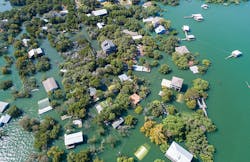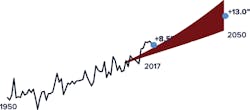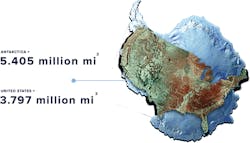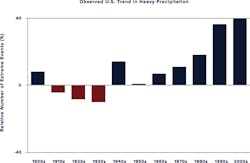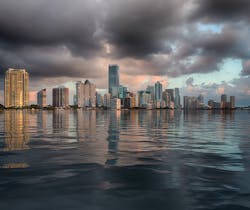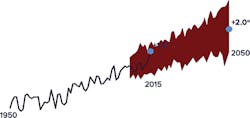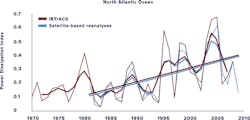Flooding is a natural process that benefits the environment by controlling erosion, protecting habitat, cultivating biological productivity, leading to groundwater recharge, and more. However, high frequency and excessive flooding can damage local ecosystems, natural habitats, and communities. For the 2019 season, the National Oceanic and Atmospheric Administration (NOAA) predicted that 200 million people in 25 states would be at risk from flooding. Flooding has cost more than $1 trillion in inflation adjusted dollars since 1980 and represents over 63% of the cost associated with all billion dollar or more disasters. Between 2000 and 2017, tidal flooding increased an average of 233% nationally according to NOAA data. Floods caused by heavy downpours are also increasing in frequency across most of the United States, especially in the Midwest and Northeast where there has been the greatest increase in heavy rainfalls (Walsh et al, 2014). To keep communities safe from the ever-growing threat of flooding, it’s important to not only understand the science behind flooding events, but what factors can worsen these events. The significant increase in flooding that has been seen over the last 20 years is largely due to changes in sea levels, surface temperatures, and sea surface temperatures, and as these environmental factors continue to change, so will flood patterns.
Sea Level Rise
The ocean has risen 8.5 inches nationally since 1950 and is projected to rise another 4.5 inches by 2050. Sea level rise can worsen floods by adding more water to already high tides; increased pressure from sea level rise can fill drainage systems, causing water to spill into the street and causing flooding even on days without rain. Higher seas also create a higher launching point for hurricane storm surge, allowing more water to come on land and travel farther with more velocity, according to the International Panel on Climate Change (IPCC) 2014 Synthesis Report. Sea level rise is governed by a number of contributing factors, with the four most prevalent being ice melt, thermal expansion, changes in ocean circulation, and land subsidence, according to a report from the National Research Council. Though a global threat, sea level rise varies by location. For example, the slowing of the Gulf Stream and sinking land contribute significantly to sea level rise on the East Coast, while the impact of ice melt and thermal expansion is felt across the coastal United States.
Thermal expansion is responsible for approximately one-third of global sea level rise, causing more than 6 inches of sea level rise since 1950. As the ocean warms, seawater becomes less dense and expands, raising sea level. Thermal expansion has increased in the last 10 years, causing sea levels to rise 75% faster than previously (CSIRO, Sea Level Rise).The loss of land-based ice causes approximately two thirds of global sea level rise (CSIRO, Sea Level Rise). Glaciers, ice caps, and ice sheets lose their mass primarily through ablation and iceberg calving, which sends over 1,700 trillion pounds of glacial ice from the land into the sea each year (Yi, et al, 2015). This includes both continental (ice sheets and ice caps) and alpine (glaciers in mountains and valleys). Mountain glaciers and ice caps have been melting for hundreds of years, but research now shows that ice sheets in Antarctica and Greenland are melting at an accelerated rate, causing them to become of greatest concern to sea level rise.
Melting of ice from Antarctica, Greenland, and glaciers is causing freshwater to disrupt the balance of the Gulf Stream. Freshwater is lighter than ocean water because it does not contain salt, therefore it does not sink as quickly and slows down the current of the Gulf Stream. Because the Gulf Stream is slowing, less water is pushed from the United States’ East Coast toward Canada and Europe, contributing to sea level rise along the East Coast of the US. Studies suggest that short-term changes to the Gulf Stream can add 1 to 3 feet to tides over the course of a day or week (Ezer, 2015). If this occurs during already high tides or rain storms, it can produce extreme flooding.
Land subsidence is generally a small contributor to sea level rise, but in certain places, like Virginia, it can be responsible for nearly half. Sea levels are measured relative to land, so when land subsidence is prevalent it can drastically increase the amount of sea level rise in a given area. For example, in Norfolk, VA, the land is sinking at a rate of approximately 1 inch every 10 years, which increases sea level rise because as the sea level rises, the ground also sinks.
Atmospheric Changes
The atmosphere is 1.9°F warmer than it was in 1950 and is projected to warm another 1.28°F by 2050, according to the US Environmental Protection Agency (EPA). This impacts the frequency and intensity of pluvial (precipitation) and fluvial (riverine) flooding, according to the IPCC 2014 report. As the atmosphere warms, there is more evaporation, which means that there is more water available for rain. This extra moisture contributes to changes in weather patterns and storm systems throughout the United States.
Over the last three to five decades, extreme rainfall events have increased in volume, intensity, and frequency, and the amount of rain falling on the heaviest rain days has also increased. The increase has been felt most in the Northwest, Midwest, and upper Great Plains, with heavy precipitation events climbing to 30% above the 1901 to 1960 average (Easterling et al, 2017). Even rain events that were once considered rare are now increasing in frequency. For example, the National Weather Service recorded ten of what were considered rare rain events between 2015 and 2016, all of which resulted in flooding. These types of rain events are generally expected to occur once every 500 years. When a precipitation event produces more water than the soil in a given area can absorb, the extra water will create runoff that flows into rivers and can overwhelm culverts and storm drains, creating flash flooding events. Urban flooding and flash floods, which are directly linked to heavy precipitation, are expected to increase as heavy precipitation events continue to increase (Melillo et al, 2014).
Increasing Sea Surface Temperature
The sea’s surface temperature, also known as upper ocean heat content, is 1.5° F warmer than it was in 1950 and is projected to rise another 0.5°F by 2050, according to EPA. Warmer ocean temperatures fuel hurricanes by giving them more water and more strength. As a result, hurricanes can reach both farther inland and farther north, are more intense when they hit, and can be sustained for longer periods of time.
As a hurricane travels over the ocean it bombards the sea surface with strong winds, which makes it easier for water to evaporate and feed the hurricane. Because the evaporation process requires energy derived from heat, the warmer the sea surface, the more energy the hurricane can gather from it (Snider, 2018). If a hurricane passes over a heated ocean surface, it can become supercharged and cause more destruction when it makes landfall than it would have without the extra heat. Stronger hurricanes are also able to reach further inland and cause more flooding because they sweep up more water and push that water with stronger winds. For example, leading up to Hurricane Harvey the ocean had one of the highest heat contents on record (Trenberth et al, 2018). This heat not only intensified the hurricane, but increased rain-driven flooding on land. The typical sea surface temperature needed for a hurricane to grow is 79°F. The near-surface ocean temperature, or heat content, before Hurricane Harvey passed over the Gulf of Mexico was 86°F, and after the hurricane passed it was still 83°F. Even though hurricanes normally cool the temperature of the ocean, leaving a cold wake, the sea surface temperature was so hot that it continued to fuel the storm, allowing it to draw power from the ocean well after it made landfall. As the ocean continues to warm, higher sea surface temperatures will be more common, contributing to stronger hurricanes and more flooding.
As sea levels continue to rise, sea surface temperatures continue to increase, and the atmosphere continues to warm, flooding will continue to worsen. Communities are continuing to grow in low-lying and coastal areas, but public understanding of increasing flood risk and how these factors contribute is not keeping pace.
Development continues in flood-prone areas with inaccurate or out-of-date flood maps being used to assess flood risk. Meanwhile, changes in drainage patterns, land use, increases in the amount of impermeable surfaces, and the reducing of many natural areas that absorb rainfall or protect against hurricane storm surge will not only worsen flooding, but leave people unprotected and unprepared. As flood risk increases, urban planning decisions should adjust accordingly, and floodplain information should be updated. More information on the limitations of FEMA maps can be found in “Understanding FEMA Flood Maps and Limitations” (www.firststreet.org/research/understanding-fema-flood-maps-and-limitations).
Selected References
Walsh, J., D. Wuebbles, K. Hayhoe, J. Kossin, K. Kunkel, G. Stephens, P. Thorne, R. Vose, M. Wehner, J. Willis, D. Anderson, S. Doney, R. Feely, P. Hennon, V. Kharin, T. Knutson, F. Landerer, T. Lenton, J. Kennedy, and R. Somerville. “Chapter 2: Our Changing Climate.” Climate Change Impacts in the United States: The Third National Climate Assessment, J. M. Melillo, Terese (T.C.) Richmond, and G. W. Yohe, Eds., U.S. Global Change Research Program, 19-67. 2014.
Commonwealth Scientific and Industrial Research Organization. “Sea Level Rise: Understanding the past–Improving projections for the future.” www.cmar.csiro.au/sealevel/sl_data_cmar.html
Yi, Shuang; Sun, Wenke; Heki, Kotsuke; Qian, An. “An increase in the rate of global mean sea level rise since 2010.” Geophysical Research Letters, 42(10), 3998-4006. 2015. www.doi.org.10.1002/2015GL063902.
Ezer, T. “Can the Gulf Stream induce coherent short-term fluctuations in sea level along the US East Coast? A modeling study.” Ocean Dynamics, 66, 207-220. 2016. www.doi.org/10.1007/s10236-016-0928-0.
Easterling, D.R., K.E. Kunkel, J.R. Arnold, T. Knutson, A.N. LeGrande, L.R. Leung, R.S. Vose, D.E. Waliser, and M.F. Wehner. “Precipitation change in the United States.” Climate Science Special Report: Fourth National Climate Assessment, Volume I [Wuebbles, D.J., D.W. Fahey, K.A. Hibbard, D.J. Dokken, B.C. Stewart, and T.K. Maycock (eds.)]. US Global Change Research Program, Washington, DC. 207-230. 2017. doi: 10.7930/J0H993CC.
J. M. Melillo, Terese (T.C.) Richmond, and G. W. Yohe, Eds. Climate Change Impacts in the United States: The Third National Climate Assessment. US Global Change Research Program, 19-67. 2014.
Snider, Laura. “Record-Breaking Ocean Heat Fueled Hurricane Harvey.” NCAR & UCAR News. University Corporation for Atmospheric Research. May 10, 2018. www.news.ucar.edu/132605/record-breaking-ocean-heat-fueled-hurricane-harvey.
University of Rhode Island Graduate School of Oceanography. “Interaction between a Hurricane and the Land.” Hurricanes: Science and Society. University of Rhode Island. www.hurricanescience.org/science/science/hurricaneandland/.
Trenberth, Kevin E.; Cheng, Lijing; Jacobs, Peter; Zhang, Yongxin; Fasullo, John. “Hurricane Harvey Links to Ocean Heat Content and Climate Change Adaption.” Earth’s Future, 6:4. May 2018. www.agupubs.onlinelibrary. wiley.com/doi/full/10.1029/2018EF000825.
For a full list of references, visit www.firststreet.org/research/environmental-science-behind-increasing-flood-trends/.
About the Author
Colleen Ensor
Colleen Ensor is a research specialist at First Street Foundation. She is responsible for UX research, product development, and digital marketing communication efforts.
